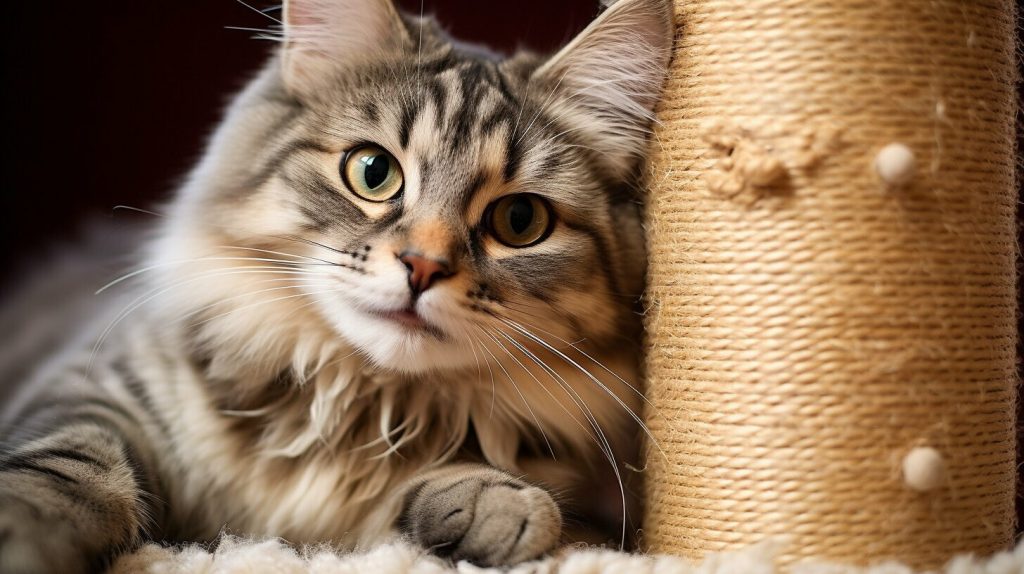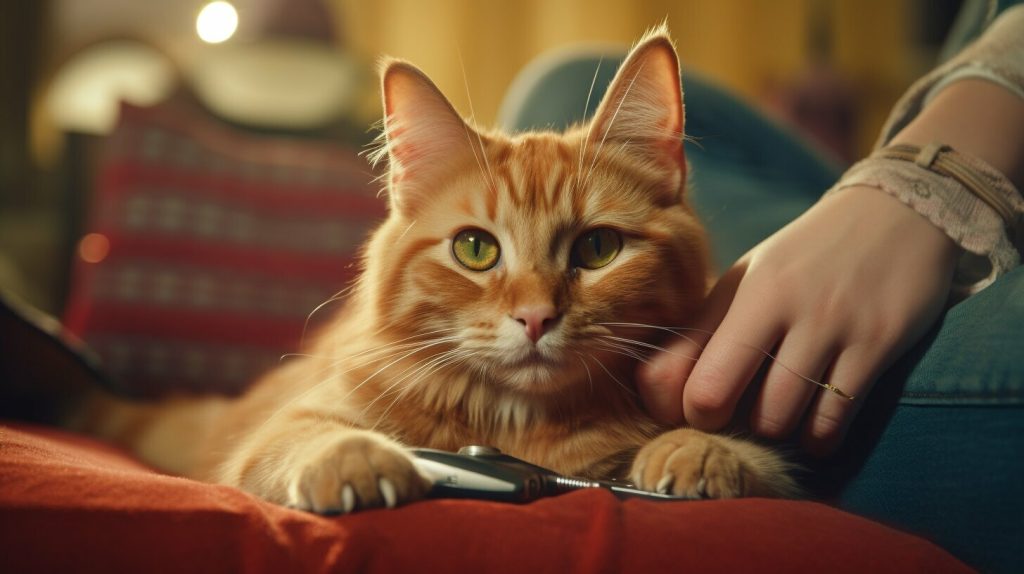Last Updated on September 22, 2023
As a cat owner, maintaining your feline friend’s health should be a top priority. One aspect that should not be overlooked is your cat’s nail care. Just like humans need to trim their nails regularly, cats require routine nail clipping to prevent overgrowth, discomfort, and potential health issues. But how often should you clip your cat’s nails?
The frequency of cat nail trims can vary depending on several factors, including your cat’s lifestyle, age, and nail growth rate. Some cats may need their nails clipped every two weeks, while others can go up to six weeks. It’s crucial to establish a proper cat nail clipping schedule to prevent overgrowth, which can lead to ingrown nails, infections, or pain for your cat.
Key Takeaways
- Regular nail clipping is essential to your cat’s health and well-being.
- The frequency of cat nail trims can vary based on your cat’s lifestyle and nail growth rate.
- Establishing a proper cat nail clipping schedule can help prevent potential health issues.
Understanding Your Cat’s Nail Growth
As a cat owner, it’s essential to understand the natural growth pattern of your feline’s nails. Unlike humans, cats’ nails grow continuously and do not fall off on their own. That’s why regular trimming is necessary to maintain the appropriate length.
How frequently you should trim your cat’s nails depends on several factors, including their growth rate and lifestyle factors. On average, indoor cats require more frequent nail trims than outdoor cats, as they have fewer opportunities to scratch on rough surfaces.
The ideal interval for clipping cat nails ranges from two to six weeks, depending on individual growth patterns. Some cats may need more frequent trims, while others may need less.
When determining when to trim your cat’s nails, observe their behavior. If they are scratching excessively or showing signs of discomfort when walking or jumping, it’s time for a nail trim. Long nails can curl into your cat’s paw pads, causing pain and infection.
It’s best to observe your cat’s nail growth and establish a regular schedule for clipping, so their nails never become too long.
By understanding your cat’s nail growth patterns and needs, you can maintain their paw health with ease.
Signs It’s Time to Trim Your Cat’s Nails
As a cat owner, it’s important to keep an eye on your feline friend’s nails to determine when it’s time for a trim. While the frequency of cat nail trims can vary depending on factors such as age, breed, and lifestyle, there are some key signs to look out for that indicate it’s time to clip your cat’s claws.
One of the most obvious signs that your cat’s nails need a trim is if they are visibly long and sharp. If you can hear your cat’s nails clicking on hard surfaces or if they are starting to curl under their paw pads, it’s time for a trim.
Another sign that your cat’s nails need attention is if they are causing damage to furniture, carpets, or other items in your home. Cats have a natural urge to scratch and stretch, but if their claws are too long, they can unintentionally cause harm.
Behavioral cues are also important to consider. If your cat is showing signs of discomfort or pain when walking or jumping, it could be a sign that their nails are too long and need to be trimmed. Additionally, if your cat is excessively licking or biting their paws, it could be a signal that their nails are bothering them.
Finally, if you’re not sure whether it’s time to trim your cat’s nails, consult with your veterinarian or a professional groomer. They can provide guidance on the recommended frequency of nail trims and help you determine if your cat’s claws are the appropriate length.
Regular nail trims are essential to your cat’s comfort and overall well-being. By monitoring your cat’s claws and recognizing the signs that it’s time for a trim, you can help prevent discomfort, damage, and potential health issues.
Tips for Successful Cat Nail Clipping
Clipping your cat’s nails can be a challenging task, but with a little patience and practice, it can become a stress-free routine. Here are some tips to ensure a successful cat nail clipping experience:
Choose the Right Tools
Start by choosing the right nail clippers. There are two types of clippers available: guillotine and scissor. Guillotine clippers are better for smaller nails, while scissor clippers are more effective for larger, thicker nails. Make sure the clippers are sharp and in good condition to avoid crushing the claw.
Handle Your Cat with Care
Before starting, find a quiet, comfortable area to clip your cat’s nails. Hold your cat firmly but gently, giving them a reassuring pat or scratch behind the ear. If your cat is nervous, try wrapping them in a towel to help them feel secure. Make sure you can see the nail clearly before clipping.
Clip the Nails Gradually
Start by trimming a small amount off the tip of the nail. Avoid the pink part of the nail, known as the quick, as this contains blood vessels and nerves. If you accidentally clip the quick, it can be painful for your cat and may cause bleeding. If in doubt, trim less rather than more, and clip gradually over several sessions if necessary.
Provide Positive Reinforcement
offer your cat plenty of praise and treats throughout the clipping process. This will help them associate the experience with positive feelings and make it easier to repeat in the future. Consider giving your cat a special treat or toy after the clipping session to reward them for their cooperation.
Maintaining the Right Length
Finally, it’s important to maintain an appropriate length for your cat’s nails. Depending on their lifestyle and natural growth rate, this may require trimming every two to four weeks. Keeping a regular schedule for nail clipping can help ensure your cat’s claws remain at a comfortable length and reduce the risk of injury or damage to furniture.
By following these tips, you can help make a necessary chore easier for you and your cat, and ensure that their nail care needs are met.
Tips for Successful Cat Nail Clipping
Now that you understand the importance of cat nail clipping and the ideal frequency, it’s time to learn some tips and tricks for a successful experience.
Choose the Right Clippers
There are a variety of nail clippers available on the market, but it’s important to find the right one for your cat. Look for clippers that are specifically designed for cats, as they will have the appropriate size and shape for your cat’s nails. Avoid using human nail clippers, as they can crush the nail and cause discomfort.
Provide Positive Reinforcement
Make sure to provide positive reinforcement during and after the nail clipping process. Offer treats or praise to help your cat associate the experience with something positive. If your cat is particularly wary of the clippers, consider scheduling a short session each day to get them used to the idea gradually.
hold your cat correctly
It’s important to hold your cat correctly during the nail clipping process to ensure their safety and comfort. Gently restrain your cat by either wrapping them snuggly in a towel or holding them securely in your lap. Be careful not to apply too much pressure or hold them too tightly, as this can cause them distress.
Maintain Adequate Nail Length
When trimming your cat’s nails, aim to cut just the tip of the nail to avoid cutting into the quick – the pink area with blood vessels. trim the nails every two weeks or so, more frequently if your cat is particularly active or has access to outdoor scratching surfaces. Regular trimming will help maintain a healthy nail length and prevent discomfort for your cat.
By following these tips, you can help ensure a stress-free cat nail clipping process for both you and your furry friend.
FAQ
Q: How often should I clip my cat’s nails?
A: The frequency of cat nail trims can vary depending on factors such as your cat’s lifestyle and nail growth rate. In general, it is recommended to trim your cat’s nails every 2-4 weeks.
Q: How can I tell when it’s time to trim my cat’s nails?
A: Look out for signs such as nails that are visibly long or curling, your cat’s nails getting caught on surfaces, or your cat scratching excessively. These are indications that it’s time to trim their nails.
Q: What are the benefits of regular cat nail trimming?
A: Regular nail trimming helps prevent issues like ingrown nails, nail splitting, and scratching furniture. It also promotes your cat’s comfort and reduces the likelihood of accidental scratches during play or handling.
Q: How do I clip my cat’s nails without causing stress?
A: Start by getting your cat comfortable with having their paws touched. Use specially designed cat nail clippers and give treats or praise during the clipping process. Take it slow and stop if your cat becomes anxious or agitated.
Q: Can I trim my cat’s nails too short?
A: Yes, it is possible to accidentally cut the quick (the sensitive part inside the nail). To avoid this, only trim the translucent, curved part of the nail and leave a small margin. If you’re unsure, consult a professional groomer or veterinarian for guidance.












